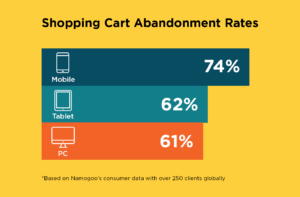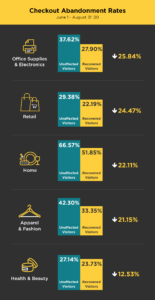Shopping cart abandonment is a universal problem, yet it happens at an astonishingly high rate in virtually every industry. By applying specific fixes, online retailers can reduce its occurrence much of the time and enjoy incremental improvements.
A Growing Problem
Shopping cart abandonment: one of the most painful phrases for an eCommerce professional to hear. Namogoo’s consumer session data from working with over 250 brands worldwide across industries shows that 69% of all visitors abandon their shopping cart mid-checkout — without much change over the last year, including before and during the COVID-19 pandemic. New visitors to an eCommerce site abandon their carts more often, at 71% of the time, than returning visitors, at 68%. Not surprisingly, mobile visitors abandon higher than those on PC or tablets:

Here are some of the most prevalent reasons why, instead of clicking ‘complete your order’, customers click away instead, and how you can prevent it.
Unwanted Surprises
Surprises can be fun — except those that mean you have to pay more or wait longer to receive your purchase. Yet these are the kinds of surprises many consumers discover right before confirming their purchase.
Unexpected – and high – shipping fees are repeatedly cited as a main reason for abandonment, as is the realization by shoppers that the total cost of their purchase was higher than they intended.
Others expect that items will be delivered within a day or two… only to find out at checkout that they’ll have to wait longer than they expected. Price and delivery time have long been deal breakers that strongly sway online customers’ purchasing decisions, but falling short of these expectations at checkout sprouts up barriers to making those purchases at the critical final step of their shopping journey.
The answer to this situation has several steps. Providing a real-time total cart cost figure at the top of the page will inform the customer when they have gone over their intended limit. Free shipping will also sometimes eliminate last minute hesitation; for shoppers in a hurry, paying a bit more for express shipping might be a worthwhile option.
Expecting more options
The eCommerce landscape is more competitive than ever nowadays. To succeed, online stores need to keep up with changing customer expectations and provide a seamless and convenient experience, or they’ll quickly find themselves falling short.
For instance, coupons and incentives are a widely-used promotional method that many shoppers apply for, but if they find redeeming these offers overly complex they will often click away. Similarly, consumers prefer the best return policy they can find, which often includes a total refund and product return at no charge. eCommerce shoppers are also accustomed to a wide range of payment methods, from common credit cards, to cryptocurrencies and digital wallets. Finally, new customers in particular aren’t always comfortable with providing credit card details on a site that is new to them, or one that doesn’t address their perceived security concerns, and will choose an online retailer with the most secure payment options.
There are many options available to online retailers to resolve these issues. Using a respected online payment system, and displaying their security seal on the checkout page, will hopefully allay any fears about credit card or personal information. Moreover, providing digital wallet solutions eliminates the need for shoppers to supply confidential data, while enabling a variety of payment options allows buyers to use the one they are most comfortable with. Websites should also make it clear on the checkout page where to apply coupons and emphasize easy returns, perhaps with a link to the full return policy and your customer service team.
Not prepared to make a purchase
As consumers, we’ve all done it. Many of us are simply checking features, brands, and prices before looking at external reviews or competing websites. Sometimes, a shopper is searching for specific product features or purchase information and can’t find it, so they look elsewhere. Other consumers fill up their cart first, and then decide if they want to buy everything immediately.
There are numerous ways to address this problem. Personalization is a vital technology in this area, so much so that the vast majority of customers expect it in the form of special offers that should occur at crucial moments in the customer journey. These include product bundles, product recommendations, and various discounts.
Live chat is another way to give users the information they seek and resolve any hesitations they may have before buying. Another is to link to external reviews while including ratings and comments in-site, adding that social proof and trust they need to make their purchase.
Suboptimal user experience
The user experience might be the most difficult aspect of shopping cart abandonment to fix. Every website is different, but there are a few classic issues that motivate customers to go elsewhere, somewhere along the way. These include long, complicated checkout processes, a slow or unstable website or app, the need to create an account to buy something, and forgotten login details.
Again, shoring up your eCommerce store will require a varied approach. If you suspect that your purchase process is less than optimal, consider best-in-class checkout page designs and apply customer journey analysis tools. If your web store crashes, then extensive debugging, mobile optimization (for apps), or a more robust infrastructure might be the solution. Finally, enabling a guest checkout format eliminates the need for account creation, and two-factor authentication will help solve the forgotten password issue.
Customer Journey Hijacking adds the worst kind of checkout disruptions
As if online retailers didn’t have enough shopping cart abandonment issues to deal with, Customer Journey Hijacking greatly exacerbates existing problems.
In a sense, traffic hijackers try to exploit the gaps in your shopping and purchase process, especially the checkout page.> By targeting shoppers with injected ads for competing products, traffic hijackers lure consumers with promotions and lower prices. Moreover, the intrusion of injected ads ruins the customer’s experience on your site because shoppers often believe that the site itself allows the ads to appear – perhaps because many are designed by traffic hijackers to look native to the hijacked site. There goes all the efforts you put into fine-tuning your UX.
Customer Journey Hijacking is a very common occurrence, with Namogoo’s consumer data indicating that it affects between 15% to 25% of online shopping sessions throughout the year.
The smartest move you’ll ever take
Namogoo’s Customer Journey Hijacking prevention solution immediately stops ad injections from running on consumers’ devices. It’s cloud-based technology can be rapidly implemented, so eCommerce stores don’t need to devote any staff or resources to setup or maintain it. Once the solution is installed, enterprises see an immediate overall conversion rate uplift by between 1.5% and 5% as shoppers are no longer affected by competing ads.
But does it work at checkout?
Namogoo constantly monitors millions of daily eCommerce transactions to gauge the effect of removing ad injections from each step of the online funnel, including checkout abandonment rates. Specifically, Namogoo compares the checkout abandonment rates of recovered visitors (site visitors previously impacted by ad injections blocked by Namogoo) to unaffected visitors (visitors not impacted by ad injections).
During August 2020 alone, checkout abandonment rates for recovered visitors were significantly lower than the rest of visitors within these industries:

In short, with one solution – compared to the many described above – eCommerce stores can immediately decrease their checkout abandonment rate and enjoy improved conversions, more loyal customers, and higher revenue.
Want to see how low you can take your checkout abandonment rate by preventing Customer Journey Hijacking? Contact us today for a free website analysis, and, during the period of COVID-19, free access to our Customer Journey Hijacking prevention solution.



